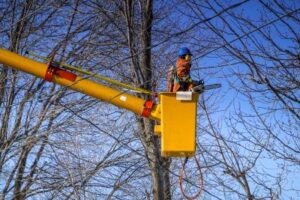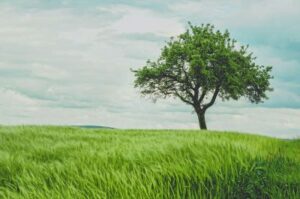What Happens If a Tree Branch Falls Onto My Neighbors House?
It’s never a pleasant situation when a tree branch falls onto your neighbor’s house. It was probably never on your mind that this could happen, but just in case it does, you will want to be prepared. I was concerned about my large Pecan Tree, so I contacted my insurance company to ask if I was liable if a tree branch fell onto my neighbor’s house.
Are you held liable if a tree branch falls onto a neighbors house? The simplest answer is no. Unless you were negligent, like leaving a pile of tree branches by the tree or purposefully pushing the tree branch onto your neighbor’s house, you are not liable for any damage to their property.
Although you might not be liable, you want to make sure that you are aware of your insurance policy. The damages will likely be covered, but you also want to double-check with your insurance company to make sure.
Can I Be Held Liable?
Whether or not you are liable for the damage is based solely on the facts of your situation. You want to take into account whether or not you were negligent and if so, how liable you would be for damages.
If you had a tree service cut away any low-hanging branches and they dropped onto your neighbor’s house, then it is likely that the claim would be denied because doing so would prevent this accident from happening in the future.
However, if your neighbor’s house was damaged as a result of a branch falling due to no action of yours (i.e., no one recently pruned the tree), then there is an excellent chance that your insurance company will cover those damages.
There might also be an investigation into what happened and who was at fault; although, another insurance company would likely take the blame.
 What Is Considered Negligence For a Fallen Tree Branch?
What Is Considered Negligence For a Fallen Tree Branch?
Pruning a tree is considered an act of negligence if it leads to a tree branch falling and damaging someone else’s property. If you are found liable for the damages, you might have to pay for the repairs yourself or through your insurance company.
Other things could be considered negligence on your part, including:
- Not trimming the branches regularly
- Allowing overgrown branches to block the view of drivers or pedestrians
- Leaving dead or dangerous branches on the tree
If any of these were the cause of the tree branch falling and damaging your neighbor’s house, you could be liable for damages.
If You Are Liable, What Could Happen?
The consequences of being liable for damages caused by a fallen tree branch can be significant. You might have to cover the cost of repairs yourself, or you might have to go through your insurance company. If the damages are significant, you could also face a lawsuit.
It’s always better to be safe than sorry, so if you have any questions about whether or not you are liable if a tree branch falls onto your neighbor’s house, contact an attorney. They will be able to look at the specific facts of your case and give you a better idea of what could happen.
If you are held liable when a tree branch falls onto a neighbors house, the damages will likely be covered by your insurance policy. However, it is important to double-check with your insurance company to make sure.
Different insurance plans will have different qualifications for liability, so it’s always good to be aware of what your specific plan covers. Contact an attorney if you have any questions about whether or not you are liable for damages caused by a fallen tree branch.
What To Do If Your Neighbor Has a Dangerous Tree Hanging
If your neighbor has a dangerous tree hanging on your property, it’s important to take action as soon as possible. The first step is to notify your neighbor of the issue. If they are not home, leave a note stating that the tree is dangerous and needs to be removed.
If they still do not take action, you may need to contact your local government to figure out the best way to remove the tree. In some cases, the government may be able to remove the tree for you at no cost.
However, if the tree is on your neighbor’s property and they refuse to remove it, you might run into some issues. This can prove to be a difficult situation, but it is important to take action to protect your property and those around you.
What Can You Do To Keep Your Tree from Becoming Dangerous?
While trees themselves might not be dangerous, unless they have brittle branches, there are a few things you can do to make sure they stay safe. These include:
- Regularly maintain your yard to keep any dead or dangerous branches from falling during a storm
- Trimming dangerous lower branches regularly so they aren’t within reach of children or pets who want to climb them
- Not allowing leaves and other debris to collect underneath your tree
 Choosing the right kind of tree. If you are concerned that your trees might become dangerous or already have falling limbs on your property, contact an arborist for help. They will be able to assess the health of your tree and recommend necessary pruning or removal.
Choosing the right kind of tree. If you are concerned that your trees might become dangerous or already have falling limbs on your property, contact an arborist for help. They will be able to assess the health of your tree and recommend necessary pruning or removal.
What Types of Trees Are the Most Dangerous?
There are a few dangerous trees that you should be careful of when maintaining your yard. These trees are more prone to losing limbs in a storm and can cause significant damage if one falls on your property or a neighboring house. These trees include:
Oak Trees
Oak trees can have weak limbs that break off easily, which could cause serious injuries if they fall on someone. If an oak tree has branches within reach height, it’s important to consider having its branches removed so as not to put people at risk.
Willow Trees
Willows tend to grow quickly and have thin bark that is often torn away from the trunk during storms. The birch inside those willow trunks is what makes the tree dangerous because it is brittle wood with sharp edges that can cut or puncture children and pets who try to play with it.
Birch Trees
Like willow trees, birch trees have dangerous bark that is sharp and dangerous for children and pets.
Elm Trees
These are dangerous because their limbs often fall due to the damage from Dutch elm disease. If a limb falls without warning, it can cause serious injuries.
Pine Trees
Pine trees are dangerous because their limbs can be very heavy and fall without warning. In addition, their needles can easily cause fires.
What Type of Trees Are Safest For a Lawn?
There are a few different types of trees that are safer for a lawn. The safest trees are those that have low branches and a shallow root system. These types of trees include maples, birches, and oaks.
However, what types of trees are safest for a lawn might also depend on what type of lawn you have. If you have a lawn with a lot of trees, then it might be safer to use smaller trees. However, if you have a lawn without any trees, then you can use taller trees.
If you have a taller tree in your yard, make sure to keep the branches trimmed so they don’t hang too low and damage the lawn. Also, be careful not to plant trees too close to the house, as their roots can damage the foundation.
 How Do Trees Fall?
How Do Trees Fall?
Although falling limbs is a natural process that happens as the tree grows and ages, trees can lose limbs and branches for a variety of reasons, including wind, ice, disease, and decay.
Wind can cause healthy branches to break off, especially if they are weakly attached to the trunk or if they are in an area where winds are strong.
Ice can also cause limbs to break off trees. Sap accumulation during warm weather can make limbs heavy and susceptible to breakage. Excessive weight can cause limbs to fall off healthy trees as well.
When healthy trees fall, they often lose limbs and branches that can pose a safety hazard to those beneath them or around them. Branches that have broken away from healthy trees may also block roads and pathways.
Property owners should check their healthy trees for signs of decay, such as cracks in the trunk or evidence of borer infestation (such as holes with sawdust-like material coming out). If healthy trees do not show signs of decay but appear weak due to a lack of limbs and branches, people should consider hiring a tree service company.
Bottom Line
Damage from a tree branch that falls onto your neighbor’s house is not usually your responsibility. However, it is always a good idea to contact your insurance company just to be sure. And if you’re at fault for damages, make sure you are fully liable and prepared to pay for the repairs yourself.
